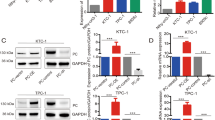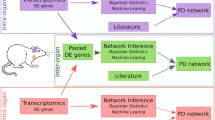Abstract
Expression of the sodium iodide symporter (NIS) gene in tumor cells may provide a novel mechanism for treating cancer. The NIS mediates the normal physiological transport of iodide across the thyroid cell membrane. This mechanism of iodide uptake has been used to both diagnose and treat thyroid cancer. Tissue expression of the NIS is largely limited to the thyroid; therefore, expression of the NIS gene in cancer cells would allow for specific iodine uptake, radioisotope accumulation, and treatment. In this study, we directly compared the human and rat NIS (rNIS) for their ability to concentrate radioisotope into human and rodent cancer cells. Perchlorate-sensitive 125I uptake in multiple cell lines was demonstrated following transduction with retroviral vectors expressing either the human or rNIS gene. Surprisingly, iodine uptake was consistently higher with the rNIS gene, up to 5-fold greater, when compared to the human gene, even within a variety of human tumor cell lines. This iodine uptake allowed for cell killing following 131I treatment in NIS-transduced cells when assayed by in vitro clonogenic assays. These results demonstrate that the rNIS gene provides superior iodine uptake ability, and may be preferable for use in designing anticancer gene therapy approaches.
This is a preview of subscription content, access via your institution
Access options
Subscribe to this journal
Receive 12 print issues and online access
$259.00 per year
only $21.58 per issue
Buy this article
- Purchase on Springer Link
- Instant access to full article PDF
Prices may be subject to local taxes which are calculated during checkout






Similar content being viewed by others
References
Carrasco N . Iodide transport in the thyroid gland. Biochim Biophys Acta. 1993; 1154: 65–82.
Mandell RB, Mandell LZ & Link CJ . Radioisotope concentrator gene therapy using the sodium/iodide symporter gene. Cancer Res. 1999; 59: 661–668.
Spitzweg C, Zhang S & Bergert ER, et al. Prostate-specific antigen (PSA) promoter-driven androgen-inducible expression of sodium iodide symporter in prostate cancer cell lines. Cancer Res. 1999; 59: 2136–2141.
Spitzweg C, O'Connor MK & Bergert ER, et al. Treatment of prostate cancer by radioiodine therapy after tissue-specific expression of the sodium iodide symporter. Cancer Res. 2000; 60: 6526–6530.
Cho JY, Xing S & Liu X, et al. Expression and activity of human Na+/I− symporter in human glioma cells by adenovirus-mediated gene delivery. Gene Ther. 2000; 7: 740–749.
Boland A, Ricard M & Opolon P, et al. Adenovirus-mediated transfer of the thyroid sodium/iodide symporter gene into tumors for a targeted radiotherapy. Cancer Res. 2000; 60: 3484–3492.
Dai G, Levy O & Carrasco N . Cloning and characterization of the thyroid transporter. Nature. 1996; 379: 458–460.
Smanik PA, Liu Q & Furminger TL, et al. Cloning of the human sodium iodide symporter. Biochem Biophys Res Commun. 1996; 226: 339–345.
Levy O, De la Vieja A & Ginter CS, et al. N-linked glycosylation of the thyroid Na+/I− symporter (NIS). J Biol Chem. 1998; 273: 22657–22663.
Eskandari S, Loo DDF & Dai G, et al. Thyroid Na+/I− symporter: mechanism, stoichiometry and specificity. J Biol Chem. 1997; 272: 27230–27238.
Ajjan RA, Kamaruddin NA & Crisp M, et al. Regulation and tissue distribution of the human sodium iodide symporter gene. Clin Endocr. 1998; 49: 517–523.
Smanik PA, Ryu KY & Theil KS, et al. Expression, exon–intron organization, and chromosome mapping of the human sodium iodide symporter. Endocrinology. 1997; 138: 3555–3558.
Link CJ Jr, Moorman D & Seregina T, et al. A phase I trial of in vivo gene therapy with the herpes simplex thymidine. Hum Gene Ther. 1996; 7: 1161–1179.
Weiss SJ, Philip NJ & Grollman EF . Iodide transport in a continuous line of cultured cells from rat thyroid. Endocrinology. 1984; 114: 1090–1098.
Yoshida A, Sasaki N & Mori A, et al. Differences in the electrophysiological response to I− and the inhibitory anions SCN− and ClO−4, studied in FRTL-5 cells. Biochim Biophys Acta. 1998; 1414: 231–237.
Kaminsky SM, Levy O & Salvador C, et al. Na+/I− symporter activity is present in membrane vesicles from thyrotropin-deprived non-I(−)-transporting cultured thyroid cells. Proc Natl Acad Sci. 1994; 91: 3789–3793.
Farrell RE Jr . RNA Methodologies: A Laboratory Guide for Isolation and Characterization. New York: Academic Press; 1993: 317
Mazzaferri E . Radioiodine and other treatments and outcomes. In: Braverman L, Utiger RD, eds. Werner and Ingbar's The Thyroid: A Fundamental and Clinical Text. Philadelphia: JB Lippincott, 1996; 922–945.
Spitzweg C, O'Connor MK, Bergert ER, Tindall DJ, Young CY & Morris JC . Treatment of prostate cancer by radioiodine therapy after tissue-specific expression of the sodium iodide symporter. Cancer Res. 2000; 60: 6526–6530.
Levy JP, Muldoon RR, Zolotukhin S & Link CJ Jr . Retroviral transfer and expression of a humanized, red-shifted green fluorescent protein gene into human tumor cells. Nat Biotechnol. 1996; 14: 610–614.
Muldoon RR, Levy JP, Kain SR, Kitts PA & Link CJ Jr . Tracking and quantitation of retroviral-mediated transfer using a completely humanized, red-shifted green fluorescent protein gene. Biotechniques. 1997; 22: 162–167.
Xu L, Yee JK, Wolff JA & Friedmann T . Factors affecting long-term stability of moloney murine leukemia virus–based vectors. Virology. 1989; 171: 331–341.
Jameson B & Wolf H . The antigenic index: a novel algorithm for predicting antigenic determinants. Comput Appl Biosci. 1988; 4: 181–186.
Tazebay UH, Wapnir IL & Levy OD, et al. The mammary gland iodide transporter is expressed during lactation and in breast cancer. Nat Med. 2000; 6: 871–878.
Parker R & Withers R . Principles of radiation oncology. In: Haskell C, ed. Cancer Treatment. Philadelphia: WB Saunders; 1995: 23–31.
Acknowledgements
We thank Sissy Jhiang (The Ohio State University) for kindly providing the full-length hNIS gene construct (FL*hNIS) and Nancy Carrasco (Albert Einstein College of Medicine, NY) for providing the anti-rNIS antibody. We also thank AD Miller (Fred Hutchinson Cancer Research Center, Seattle, WA) and A Bank (Columbia University, NY) for providing retroviral vectors and packaging cell lines. This research was supported by Research Project Grant no. RPG-98-091-01-MBC from the American Cancer Society and by US Department of Defense Grant no. PC010633.
Author information
Authors and Affiliations
Corresponding author
Rights and permissions
About this article
Cite this article
Heltemes, L., Hagan, C., Mitrofanova, E. et al. The rat sodium iodide symporter gene permits more effective radioisotope concentration than the human sodium iodide symporter gene in human and rodent cancer cells. Cancer Gene Ther 10, 14–22 (2003). https://doi.org/10.1038/sj.cgt.7700525
Received:
Published:
Issue Date:
DOI: https://doi.org/10.1038/sj.cgt.7700525
Keywords
This article is cited by
-
Sodium/iodide symporter gene transfection increases radionuclide uptake in human cisplatin-resistant lung cancer cells
Clinical and Translational Oncology (2015)
-
Wild-type p53 enhances the cytotoxic effect of radionuclide gene therapy using sodium iodide symporter in a murine anaplastic thyroid cancer model
European Journal of Nuclear Medicine and Molecular Imaging (2010)
-
Rat sodium iodide symporter allows using lower dose of 131I for cancer therapy
Gene Therapy (2006)



